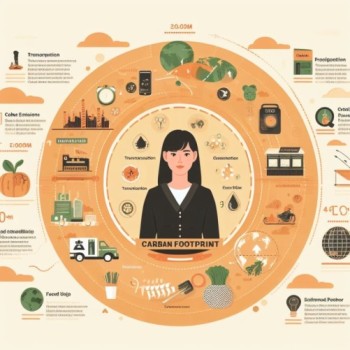
Imagine you’re sitting at a tea party with your favorite stuffed animals. You start telling them about something called “net zero.” But how do you explain it in a way that they can understand? Well, imagine you have a big jar filled with yummy cookies, and you want to share them with your friends. But you also want to make sure you have enough cookies left for later. That’s kind of like net zero! It’s when we use up things like energy and resources, but we also make sure to give back and take care of the Earth, so that there’s always enough for everyone, including all the plants, animals, and people.
What is Net Zero?
Net Zero is a goal that we can all work towards in order to help protect our planet and ensure a healthy and sustainable future for everyone. It means that we want to reduce the amount of harmful gases, called greenhouse gases, that are released into the Earth’s atmosphere. By doing this, we can make sure that the amount of greenhouse gases that are produced is equal to the amount that is removed. This is really important because greenhouse gases, like carbon dioxide, are causing the Earth’s temperature to rise and leading to climate change.
Understanding Carbon Footprint

What is a carbon footprint?
Have you ever heard of a carbon footprint? It’s not a real footprint you can see with your eyes, but it’s a way to measure how much carbon dioxide and other greenhouse gases you are responsible for producing. It’s like a little mark on the Earth that shows how much you are contributing to the problem of climate change. Everyone has a carbon footprint because we all do things in our daily lives that release greenhouse gases. Some examples of things that can contribute to your carbon footprint are using electricity, driving a car, and even eating certain foods.
How is carbon emitted?
Carbon is emitted, or released, into the air when we do things that involve burning fossil fuels. Fossil fuels are things like coal, oil, and natural gas. We use these fuels to create electricity, power our cars and buses, and heat our homes. When we burn these fuels, carbon dioxide is released into the air. This carbon dioxide then traps heat in the Earth’s atmosphere and causes the planet to get warmer.
Examples of carbon emissions
There are many things in our daily lives that can cause carbon emissions. For example, when you turn on the lights in your house, the electricity that powers them may be generated by burning fossil fuels. When we drive cars that run on gasoline, they release carbon dioxide into the air. Even the food we eat can have carbon emissions, especially if it has to be transported from far away. Every time we use energy or produce something, we need to think about how it contributes to our carbon footprint.
Why is Net Zero Important?
The impact of greenhouse gases
Greenhouse gases, like carbon dioxide, are really important for our planet. They help to keep the Earth warm and make it possible for us to live here. But when we produce too many greenhouse gases, it can cause big problems. The Earth’s temperature starts to rise, causing ice in the polar regions to melt, sea levels to rise, and extreme weather events like hurricanes and heatwaves to become more frequent. By working towards net zero, we can reduce the amount of greenhouse gases in the atmosphere and prevent these harmful effects from happening.
Preventing climate change
Climate change refers to the long-term changes in temperature, rainfall, and weather patterns that are happening all around the world. It is caused by the increase in greenhouse gases in the atmosphere, mainly from burning fossil fuels. Climate change can have serious consequences for humans, animals, and plants. It can lead to more droughts, floods, and wildfires, which can harm our homes, destroy crops, and make it difficult for animals to survive. By achieving net zero, we can slow down and eventually stop the process of climate change.
Protecting the environment for future generations

One of the most important reasons why net zero is important is that it helps to protect the environment for future generations. Imagine a world where the air is clean and safe to breathe, where the oceans are healthy and full of life, and where plants and animals can thrive. That’s the kind of world we want to leave for our children and grandchildren. By reducing our carbon footprint and working towards net zero, we can make sure that the Earth remains a beautiful and livable place for generations to come.
How Does Net Zero Work?
Reducing carbon emissions
reducing carbon emissions is a big part of achieving net zero. It means finding ways to use less energy and produce less carbon dioxide. One way to do this is by using energy-efficient appliances and light bulbs in our homes. These appliances use less electricity, which means less fossil fuels are burned to generate that electricity. Another way to reduce emissions is by using public transportation instead of driving a car. When more people ride buses or trains, there are fewer cars on the road, which means less carbon dioxide is released into the air.
Using renewable energy sources
Another important part of net zero is using renewable energy sources. Renewable energy comes from sources that can be replenished, like the sun, wind, and water. Instead of burning fossil fuels, we can generate electricity by using solar panels, wind turbines, and hydroelectric dams. These sources of energy don’t produce carbon dioxide or other greenhouse gases, so they are much better for the environment. Plus, they will never run out, unlike fossil fuels, which will eventually be used up.
Carbon offsets and removals
Sometimes, even if we try our best to reduce our carbon emissions, we still produce some greenhouse gases. That’s where carbon offsets and removals come in. Carbon offsets are projects that reduce or remove greenhouse gases from the atmosphere, like planting trees or investing in renewable energy projects. When we support these projects, we are offsetting, or balancing out, the emissions we can’t avoid. It’s like taking back some of the carbon dioxide that we released into the air. This helps us achieve net zero by making sure the amount of greenhouse gases in the atmosphere is equal to the amount that is being removed.
Net Zero and Energy Consumption

Conserving energy at home
Conserving energy means using less electricity and being mindful of how we use energy in our daily lives. There are many things you can do at home to conserve energy. For example, you can turn off lights and electronics when you’re not using them. You can also unplug chargers and appliances that are not in use because they still use energy even when they’re not turned on. Another way to conserve energy is by using natural light during the day instead of always turning on lights, and by using blankets or sweaters instead of turning up the heat.
Using energy-efficient appliances

Energy-efficient appliances are designed to use less electricity while still providing all the functions you need. For example, an energy-efficient light bulb produces the same amount of light as a regular light bulb but uses less energy. When you’re choosing appliances like refrigerators, televisions, or washing machines, look for the Energy Star label. This label tells you that the appliance is energy efficient and will help you save energy and reduce your carbon footprint.
Renewable energy in everyday life
Renewable energy is becoming more and more popular, and it’s something you can use in your everyday life too. If your family has the option, you can choose to power your home with renewable energy instead of energy generated from fossil fuels. You can install solar panels on your roof to generate electricity from the sun, or you can purchase renewable energy from your electricity provider. Some homes even have wind turbines in their yards to generate electricity from the wind. By using renewable energy, you can reduce your carbon footprint and help achieve net zero.
Net Zero and Transportation
The role of transportation in carbon emissions
Transportation, like cars, trucks, and planes, plays a big role in carbon emissions. When we burn gasoline or diesel fuel to power our vehicles, carbon dioxide is released into the air. This is a major source of greenhouse gas emissions. In order to achieve net zero, we need to find ways to reduce our reliance on fossil fuels for transportation and transition to cleaner alternatives.
Using public transportation and walking/biking

One way to reduce our carbon footprint from transportation is by using public transportation, like buses or trains, instead of driving a car. When we all ride a bus together, it means there are fewer cars on the road, and that means less carbon dioxide is emitted. Another great way to reduce carbon emissions is by walking or biking whenever possible. It’s good for our health and good for the environment too!
Transitioning to electric vehicles
Another important step in achieving net zero is transitioning to electric vehicles. Electric vehicles, or EVs, run on electricity instead of gasoline or diesel. They produce zero tailpipe emissions, which means they don’t release any carbon dioxide into the air while driving. By switching to EVs, we can greatly reduce our transportation-related carbon emissions. Plus, they’re really cool because they’re quiet and don’t use any gas!
Net Zero and Sustainable Practices
Reducing waste and recycling
Reducing waste and recycling are important sustainable practices that can help us achieve net zero. When we throw things away, they end up in landfills, where they release greenhouse gases as they decompose. By reducing the amount of waste we produce, we can reduce these emissions. One way to do this is by recycling. Instead of throwing things in the trash, we can separate our recyclables, like paper, plastic, and glass, and give them a second life by turning them into new products.
Conserving water

Water is a precious resource, and we need to use it wisely. Conserving water means using it carefully and not wasting it. There are many ways to conserve water, like turning off the faucet while brushing your teeth, taking shorter showers, and fixing any leaks in your home. By using less water, we can reduce the energy needed to pump and treat it, which in turn reduces our carbon footprint.
Supporting sustainable agriculture
Did you know that the food we eat can also have an impact on our carbon footprint? Some types of farming practices can release a lot of greenhouse gases. That’s why it’s important to support sustainable agriculture. Sustainable agriculture is a way of growing food that takes care of the environment and helps to reduce carbon emissions. This can include things like using organic farming methods, rotating crops, and reducing the use of chemicals. By choosing sustainably grown food, we can help protect the planet and achieve net zero.
Taking Action at Home
Getting involved in energy-saving actions
There are many energy-saving actions you can take at home to help achieve net zero. You can start by turning off lights and electronics when you’re not using them, just like we talked about earlier. You can also help your family set the thermostat a little lower in the winter and a little higher in the summer to save energy. Another fun way to get involved is by helping your family plant trees or start a garden. Trees absorb carbon dioxide from the air, so they can help reduce our carbon footprint.
Educating others about net zero

Another important way to take action is by educating others about net zero. You can talk to your friends, family, and classmates about why it’s important to reduce our carbon emissions and work towards a net zero future. You can share what you’ve learned with them and encourage them to take small steps to reduce their carbon footprint too. Remember, even small changes can make a big difference when we all work together.
Being a responsible consumer
Being a responsible consumer means making choices that help protect the environment and reduce our carbon footprint. You can do this by supporting companies that use renewable energy and have sustainable practices. When you go shopping, you can also look for products that have less packaging or are made from recycled materials. By being mindful of what we buy and where it comes from, we can make a positive impact on the planet and contribute to achieving net zero.
Net Zero in the World
International efforts to achieve net zero
Net zero is not just something that one country or one person can achieve alone. It requires global cooperation and collaboration. That’s why many countries around the world have made commitments to achieve net zero by a certain year, like 2050 or 2060. They are working together to reduce their carbon emissions and transition to clean and renewable energy sources. By joining forces, we can make a bigger impact and create a more sustainable future for everyone.
Impacts of net zero on the global community
Achieving net zero has many positive impacts on the global community. It means cleaner air to breathe, healthier oceans and forests, and a more stable climate. When we reduce our carbon emissions, we also reduce the negative effects of climate change, like extreme weather events and rising sea levels. This benefits not only humans, but also all the plants and animals that call Earth home.
Collaborating for a sustainable future

Collaboration is key when it comes to achieving net zero and creating a sustainable future. It’s important for governments, businesses, communities, and individuals to work together and share ideas and resources. We can all contribute in different ways, whether it’s through reducing our own carbon footprint, supporting clean energy initiatives, or advocating for sustainable policies. By collaborating, we can build a better world for ourselves and future generations.
Exploring the Benefits of Net Zero

Improved air quality
One of the benefits of achieving net zero is improved air quality. When we reduce our carbon emissions, we also reduce the amount of air pollution caused by burning fossil fuels. This means cleaner, fresher air for us to breathe. Improved air quality can have positive effects on our health, reducing the risk of respiratory diseases, allergies, and other health problems.
Clean and renewable energy sources
Another major benefit of net zero is the transition to clean and renewable energy sources. Instead of relying on finite fossil fuels, we can harness the power of the sun, wind, and water to generate electricity. This means we can have a constant and renewable supply of energy without harming the environment. Clean energy sources also create new job opportunities and contribute to the growth of a green economy.
Preserving natural habitats
By achieving net zero, we can also help preserve natural habitats for plants and animals. Climate change is causing many habitats to change or disappear completely, putting countless species at risk. When we reduce our carbon emissions and prevent further climate change, we give these habitats a better chance of surviving and thriving. This allows animals to continue living in their natural homes and helps to maintain the biodiversity of our planet.
In conclusion, achieving net zero is a crucial goal for creating a sustainable and healthy future for our planet. By understanding our carbon footprint, reducing our emissions, using renewable energy sources, and making sustainable choices in our daily lives, we can all contribute to achieving net zero. It’s important to educate others about the importance of net zero and collaborate with individuals, communities, and governments around the world to create a more sustainable future. Together, we can protect the environment, prevent climate change, and preserve our planet for generations to come.


